Hidden Habitats Of The Mexican Wolf

Have you ever wondered where the Mexican wolf roams? These majestic creatures, also known as "El Lobo," inhabit some of the most remote and rugged terrains in North America. Found primarily in the southwestern United States and northern Mexico, these wolves thrive in forests, grasslands, and mountainous regions. Their habitats are rich in biodiversity, offering plenty of prey like deer and elk. Despite their beauty, Mexican wolves face numerous challenges, including habitat loss and human conflict. Understanding their habitats helps us appreciate their role in the ecosystem and the importance of conservation efforts. Ready to learn more about these incredible animals? Let's dive into their world.
The Enigmatic Mexican Wolf
The Mexican wolf, also known as "El Lobo," is one of the most elusive and endangered animals in North America. These majestic creatures once roamed vast territories, but now their habitats are limited to a few hidden gems. Let's uncover some of these secret spots where the Mexican wolf still roams.
1. Apache-Sitgreaves National Forests
Located in Arizona and New Mexico, the Apache-Sitgreaves National Forests offer a sanctuary for the Mexican wolf. This area provides dense forests, open meadows, and abundant prey, making it an ideal habitat.
- Dense Forests: Thick woods provide cover and safety.
- Open Meadows: Perfect for hunting and socializing.
- Abundant Prey: Deer and elk are plentiful here.
2. Blue Range Wolf Recovery Area
Straddling the border between Arizona and New Mexico, the Blue Range Wolf Recovery Area is a critical zone for the survival of the Mexican wolf. This region is specifically managed to support wolf populations.
- Protected Area: Special regulations to ensure wolf safety.
- Diverse Terrain: Mountains, valleys, and rivers.
- Monitoring Programs: Scientists track and study wolf behavior.
3. Gila National Forest
Gila National Forest in New Mexico is another key habitat for the Mexican wolf. This forest is known for its rugged landscapes and rich biodiversity.
- Rugged Landscapes: Ideal for wolves to roam freely.
- Rich Biodiversity: Home to various prey species.
- Remote Location: Less human interference.
4. Coronado National Forest
Coronado National Forest, stretching across Arizona and New Mexico, offers a mix of desert and forest environments. This unique combination supports a diverse range of wildlife, including the Mexican wolf.
- Desert and Forest Mix: Varied habitats for different needs.
- Diverse Wildlife: Wolves coexist with other species.
- Scenic Beauty: Stunning landscapes for exploration.
5. White Mountain Apache Reservation
The White Mountain Apache Reservation in Arizona plays a crucial role in the conservation of the Mexican wolf. The reservation's efforts to protect and reintroduce wolves have been instrumental in their survival.
- Conservation Efforts: Active programs to support wolf populations.
- Cultural Significance: Wolves hold a special place in Apache traditions.
- Protected Lands: Safe haven for wildlife.
6. San Carlos Apache Reservation
Another important area is the San Carlos Apache Reservation in Arizona. This reservation has been involved in various initiatives to help the Mexican wolf thrive.
- Initiatives: Programs aimed at wolf recovery.
- Community Involvement: Local support for conservation.
- Natural Habitat: Pristine environments for wolves.
7. Aldo Leopold Wilderness
Named after the famous conservationist, the Aldo Leopold Wilderness in New Mexico is a pristine area where the Mexican wolf can be found. This wilderness area is part of the Gila National Forest.
- Pristine Wilderness: Untouched landscapes.
- Conservation Legacy: Named after a pioneer in wildlife conservation.
- Ideal Habitat: Supports a healthy wolf population.
Protecting the Mexican Wolf's Future
The Mexican wolf faces many challenges, but efforts to protect its habitats are crucial. Conservation programs and protected areas play a big role in ensuring their survival. By supporting these initiatives, we can help maintain the balance of the ecosystems where these wolves live.
Educating the public about the importance of the Mexican wolf and its environment can also make a difference. When people understand the value of these animals, they are more likely to support conservation efforts.
Every small action counts. Whether it's donating to wildlife organizations, spreading awareness, or advocating for stronger protection laws, everyone can contribute. The future of the Mexican wolf depends on collective efforts to safeguard its natural habitats. Let's work together to ensure these magnificent creatures continue to thrive in the wild.

